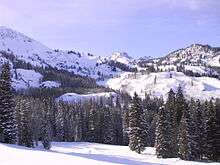Big Cottonwood Creek
| Big Cottonwood Creek | |
| River | |
 Big Cottonwood Creek near Big Cottonwood Park | |
| Country | United States |
|---|---|
| State | Utah |
| Source | |
| - location | Brighton, Utah, Salt Lake County, Utah |
| - elevation | 9,600 ft (2,926 m) [1] |
| - coordinates | 40°36′0″N 111°35′0″W / 40.60000°N 111.58333°W |
| Mouth | Jordan River |
| - location | Murray, Utah, Salt Lake County, Utah |
| - elevation | 4,250 ft (1,295 m) [1] |
| - coordinates | 40°40′47″N 111°54′42″W / 40.67972°N 111.91167°WCoordinates: 40°40′47″N 111°54′42″W / 40.67972°N 111.91167°W |
| Length | 26 mi (42 km) [2] |
| Basin | 43 sq mi (111 km2) [2] |
| Discharge | for Murray, Utah |
| - average | 31.3 cu ft/s (1 m3/s) [2] |
| - max | 380 cu ft/s (11 m3/s) |
| - min | 5.0 cu ft/s (0 m3/s) |
_Watershed.jpg) Little Cottonwood Creek and other Salt Lake County streams | |
Big Cottonwood Creek is one of the largest streams entering Salt Lake Valley from the east from the Wasatch Mountains. The creek flows through the Big Cottonwood Canyon in a westerly direction until it emerges into Salt Lake Valley about eighteen miles (29 km) from its highest source. Thence its course is northwesterly through Cottonwood Heights, Holladay, and Murray, Utah until it empties into the Jordan River about five miles (8 km) south of Salt Lake City. In the summer its waters are all used for irrigation purposes. From its source to its original outlet into the Jordan River is a distance of about twenty six miles.[3]
Hydrology
The creek flows from around 9,600 feet (2,900 m) at the headwaters to around 4,250 feet (1,300 m) when it reaches the confluence with the Jordan River. The stream flows in a northwest direction as it leaves the headwaters near Brighton and then travels southwest about halfway down the canyon near Reynolds Gulch. At the base of the canyon the stream leaves the Uinta-Wasatch-Cache National Forest and a portion of the flow enters the Big Cottonwood Treatment Plant to provide municipal drinking water. At this point the stream again flows northwest until the confluence with the Jordan River around the Murray area.[4]

The source waters at the top of the canyon begin near the Brighton Ski Resort and flow from Silver Lake, Twin Lakes Reservoir, Lake Mary, Lake Martha, Lake Catherine, and Dog Lake. Additionally precipitation and many tributaries along the canyon contribute to Big Cottonwood Creek’s water volume. Brighton receives over 50 inches (1,300 mm) of precipitation annually, most in the form of snow. 400 inches of total annual snowfall are measured. The average water yield of Big Cottonwood Creek is 52,864 acre feet (65,207,000 m3), which is the highest water yield of any Wasatch Front canyon stream in Salt Lake County. This canyon is a protected watershed area under strict management controls since it is a major source of drinking water for Salt Lake City. No dogs or horses are allowed. The water quality provides an excellent source for drinking water.[4]
Flooding is relatively rare for this creek. In the summer of 2010, Big Cottonwood Creek hit 4.1 feet (1.2 m) above the waterline. The flood stage for the urban waterways is 4.2 feet (1.3 m).[5]
Big Cottonwood Canyon and the surrounding Uinta-Wasatch-Cache National Forest have a long history of resource use and development. As Salt Lake City grew through the mid-19th century to early 20th century tremendous demands were placed on natural resources through population growth, mining, railroading, and manufacturing. The canyons were stripped of timber, forage, and minerals by 1900. A serious impact was the timber industry’s sawmills. The first mills were two mills built in the lower portion of Big Cottonwood Canyon by 1850 and in the next decade the mills moved up the canyon. Today the canyon continues to be impacted through recreational demands and urban pressure.[4]
Recreation
Outdoor activities in the canyon include fishing, seasonal hunting, camping, hiking, picnicking, sightseeing, biking, rock climbing, skiing, and snowboarding. The National Forest land in the canyon is intermixed with private land. The private land contains many homes, some of which are right alongside Big Cottonwood Creek. Two large ski resorts are also located in the canyon. All of these activities further influence this ecosystem.[6]
Fauna

Big Cottonwood Creek is home to rainbow trout (Oncorhynchus mykiss), brook trout (Salvelinus fontinalis), and brown trout (Salmo trutta) and the native Bonneville cutthroat trout (Oncorhynchus clarki utah). The Utah Division of Wildlife Resources stock the creek with rainbow trout annually near Silver Lake. The Utah Division of Wildlife Resources has identified Big Cottonwood Creek as a Class II Fishery. This classifies the area as “a moderate to large productive stream with high aesthetic value where fishing and other recreational uses should be the primary consideration”. It was determined to be an especially important water body due to its capacity to provide a strong resident trout fishery close to a metropolitan area.[4]
See also
References
- 1 2 Google Earth elevation for GNIS coordinates. Retrieved on 2010-06-08.
- 1 2 3 "#390 BIG COTTONWOOD CREEK @ 300 WEST" (PDF). SALT LAKE COUNTY PUBLIC WORKS DEPARTMENT ENGINEERING DIVISION. September 2004. Retrieved 2010-06-08.
- ↑ Andrew Jenson; The Historical record: a monthly periodical devoted exclusively to historical, biographical, chronological and statistical matters, Volumes 5-8 Publisher: A. Jenson., 1889
- 1 2 3 4 Kate Schwager, Paul K. Cowley; BIG COTTONWOOD CREEK Stream Survey Report. United States Department of Agriculture. Wasatch-Cache National Forest Salt Lake Ranger District November 2000
- ↑ Stettler, Jeremiah; Cleanup begins as flooding eases. The Salt Lake Tribune June 8, 2010
- ↑ Brett Prettyman, Tom Wharton; Fishing Utah. Publisher Globe Pequot, 2001 ISBN 1-56044-983-7